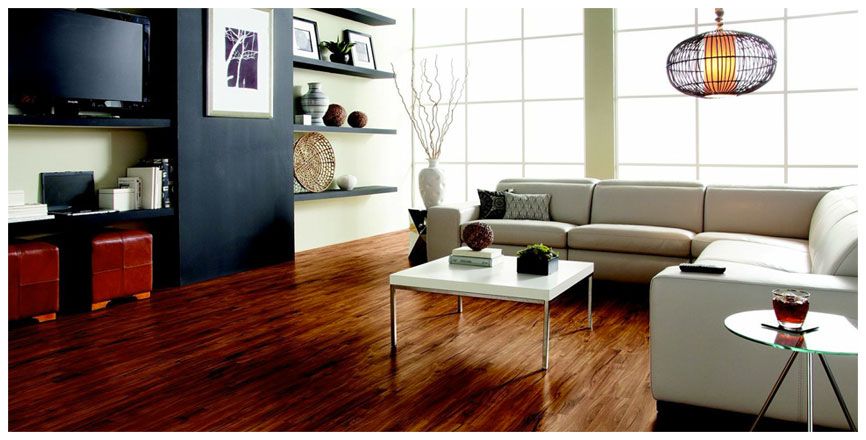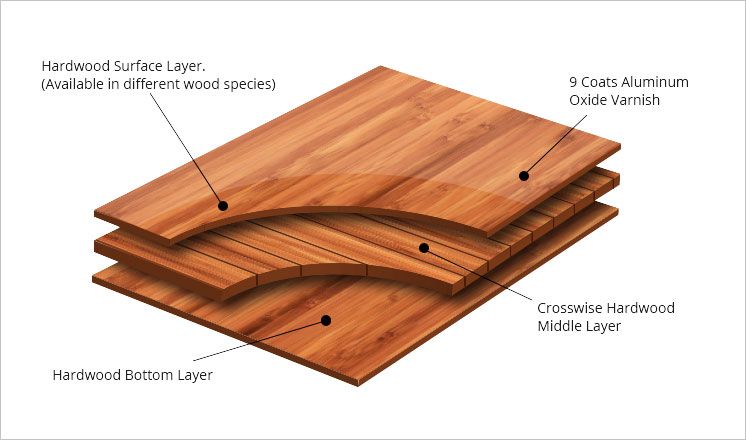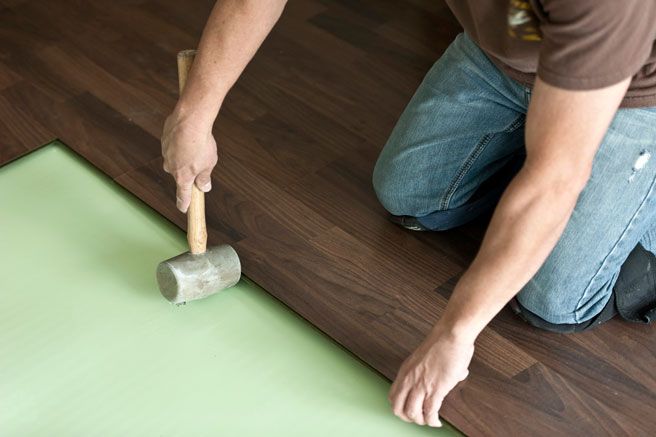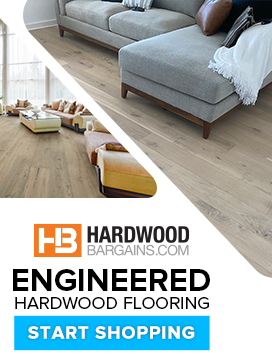About Engineered Hardwood Flooring
A common misconception is that engineered hardwood flooring, also known as composite wood flooring, is not real wood. The truth is, these products are comprised entirely of real wood, but done so in a process that makes them both cost-effective, and structurally stable. These flooring products provide the same aesthetic look and feel as solid hardwood, and many times come with lifetime warranties. Here are some reasons why engineered hardwood floors may be the flooring you are looking for:
- They are composed of real wood from top to bottom.
- The core of the product is produced with layers of real wood whose grain pattern is placed in opposing directions. This "locks" the floor in place, making it less susceptible to warping and cupping over a traditional solid wood floor.
- The planks are typically pre-finished, which means a quick and clean installation, with a surface backed by a manufacturer's warranty.
- They are easier to install, making the product a great DIY solution.
- Once installed, they look and feel just like a solid wood floor.
- They come in wider width options - some as wide as 7"-9". This is not typically possible in a solid floor, because of the structural integrity of the plank, making the engineered option for flooring a great solution to this grand look.
Engineered hardwood flooring is increasing in popularity. In addition to looking and feeling like more expensive, solid wood floors, they tend to be a cheaper, more resilient solution which is less susceptible to humidity and heat conditions.
How It Is Made
Engineered hardwood flooring is made of layers of various kinds of durable plywood and glue. The top layer is known as the wear layer and it is thick hardwood that is made from the same types of materials that solid hardwood floors are made from.
To support the wear layer and give this composite flooring its durability, you will find several layers of plywood and softwood in various arrangements. The multiple layers of thin plywood give this type of flooring durability that laminate lacks, and the softwood gives your floor a bounce that makes it comfortable to walk on.
The composite hardwood planks come in a variety of widths and can be used in a variety of floor designs. One of the most convenient things about engineered flooring is that it looks exactly like a hardwood floor, but it offers more comfort and installation options than a hardwood. The hardwood planks are made with a tongue-and-groove design that makes them easy to install.
Construction Materials
As you shop for your new floor, take the time to examine the materials that go into making the flooring. Laminate flooring is made using composite wood chips that are formed into planks of laminated timber and topped with a photographic image of a flooring species. Laminates are excellent for bedrooms and family rooms, but they are not as resilient to water as flooring that has been engineered.
Engineered flooring is made of all wood from top to bottom. Each brand uses its own method for fabricating the wood, but the core process uses all solid plywood and real hardwood products. Aside from the occasional layer of ground-up stone for durability, you will find that all engineered flooring is made from layers of real wood, without the use of composites.
One advantage of using this type of flooring is its durability. The solid wood that is built into this flooring means that it offers durability that is very similar to other hardwood options. All engineered wood comes with a finished top layer that is ready for installation.
Comparing Engineered To Solid Hardwood
When you buy engineered Brazilian cherry hardwood flooring, the floor you are walking on will be real Brazilian cherry wood. It will have the same look and feel as any other Brazilian cherry hardwood floor.
Solid hardwood flooring offers a beauty that is difficult to match. For most people, there is nothing that tops the durability and aesthetic appeal of a solid hardwood floor. A solid hardwood floor is going to expand and contract with your room during the changes in the weather, which means that a solid hardwood floor will retain its beauty all year round.
Engineered wood flooring has that same beauty because the top layer is made from the same species of wood as your solid hardwoods. This prefabricated wood can also change with the seasons and is also excellent for below-ground rooms that may experience a little moisture from time to time.
The Benefits
The process for making engineered or composite wood has been around for a long time, and the latest technology has helped to make the process even better. When this composite hardwood is installed, it can be extremely difficult to tell the difference between the engineered floor and a real hardwood floor.
Since the engineering process typically builds in tongue and groove features, this makes it a floor that you can install on your own. You always have the option of nailing to the sub-floor, but it is not necessary. The DIY nature of engineered flooring makes it very popular among people who prefer to save money by doing projects on their own.
A further benefit is that it will last for a very long time and it is extremely easy to care for. You can use traditional hardwood floor cleaning products on your floor and you will get excellent results.
An engineered floor tends to be a little more resilient to the scratches and marks left by moving furniture or other items across the floor. That is why many people use it for their family rooms and recreational rooms. The specific construction is able to withstand moisture better than solid hardwood and laminate, so its resiliency to scratches makes it an ideal choice for heavy traffic rooms.
After many years of use and waxing, your floor may start to show its age. When that point comes, you can bring in a professional contractor to do a light sanding of your floor and restore its beauty. Most engineered floors can be safely sanded twice in their lifetime.
When To Use It
Engineered flooring can be used in any room of the house and it will give you that deep, rich look you would get with real hardwood. In addition, due to its durable construction, there are a few types of situations where composite hardwood is preferred over any other kind of flooring.
Radiant heating is a type of system that installs heating coils in the floor and then allows the heat to radiate throughout the room. It is a type of heating that is becoming extremely popular because it heats a room evenly and can be more cost-effective than other forms of heating.
A solid hardwood floor cannot be installed over a radiant heating system and a laminate would not be able to withstand the heat for more than a few years. That is why engineered is absolutely ideal for rooms with radiant heating.
The layers of plywood are installed in a criss-cross pattern that offers durability that no other flooring can deliver. That criss-cross pattern makes engineered floors ideal for basements and garages that are being remodeled into living spaces.
The biggest challenges with basement or garage floors are the cold concrete sub-floors and the moisture that tends to gather in both areas. A solid hardwood floor would have difficulty handling the constant changes in moisture and temperature, as would a laminate floor. But because of the design of an engineered floor, it is ideal for any kind of remodeling project where you are turning unused space into a living area.
When you are remodeling a home, you can often find that fitting hardwood flooring in doorway transitions can be difficult because solid hardwood is so thick. Engineered hardwood is traditionally only 1/4-inch thick and can easily be used in any room during any remodeling project.
Another convenient aspect of the engineered option is its versatility when it comes to installation. You can lay them over concrete, linoleum, tile, or an existing wood floor and it will work just fine. Solid hardwood floors require a level plywood subfloor for installation, which can sometimes make a project take longer and cost more.
Grading
We have talked at great length about the layers in an engineered floor and how those layers add to the floor's durability. Now let's take a look at the different grades so that you can get an idea as to what kind of floor would be ideal for your project.
Judging A Floor
The packaging for most engineered products will allow you to see the layers the floor is made from, or it will include a diagram of the different layers. It is always best to look for a thick top layer and as many finishing coats as possible. The finishing coats will offer extra protection to your flooring and allow you to get more out of your investment.
The rule of thumb for composite flooring is the more layers of plywood you have, the better the floor. You should also check the warranty on your flooring to see how long your investment will be protected. Traditional warranties run anywhere from 10 to 30 years.
First Level
A good engineered plank is 1/4-inch thick with anywhere up to five finishing layers on it. The top layer should be around 2 mm thick, and there should be at least three support layers of plywood.
Second Level
As you move up to the second level, you will notice that the planks are still 1/4-inch thick, but there are seven finishing coats instead of just five. Your hardwood top layer is around 3 mm thick, and there are anywhere between five to seven support layers under the hardwood.
Third Level
The third level of is where you start to see some of the special finishes such as hand-scraped and wire-brushed. The planks at this level can be as much as 3/4-inch thick, and the top layer of hardwood is usually slightly more than 3 mm thick.
There can be anywhere from seven to nine finish coats over the hardwood on these products, and at least seven to nine support layers of plywood. The products at this level of flooring tend to come in a wide variety of species and colors. You will also be able to choose a narrow or wide plank at this level, which will help add variety to your project.
Species & Finishes
One of the fun parts of picking out your engineered flooring is deciding what species and finish you want. Composite offers the same variety of species that you would find with solid hardwoods. That means that you can enjoy the deep, rich look of a Cherry floor, or you can get a bright finish with White Oak.
You can get a smooth oil finish to your engineered hardwood flooring, or you can go for a different effect. A wire-brushed floor has a texture to it that is pleasing to walk on and can grab the sunlight in interesting ways. For a rural or rusting look, consider the grooved design in a hand-scraped floor that will definitely add character to any room.
Installing Engineered and Solid Wood Floors
In order to have your solid hardwood floor installed properly, it is best to have the job done by an expert installer. Nails and glue are required to affix the solid hardwood floor to a level plywood sub-floor. When a solid hardwood floor is properly installed and sealed, it is going to be extremely durable and stand up to a wide variety of abuse. You can find a certified professional installer in your area here.
Engineered hardwood floors can also be affixed to a level plywood subfloor using nails and glue, or it can installed as a floating floor. You can simply lay an engineered floor over an environmental barrier and not have to do any nailing or gluing. The advantages to a floating floor are that it is softer to walk on and you reduce the chances of the floor buckling as it expands and contracts.
Caring For Your Floor
You would care for an engineered floor in much the same way that you would care for a solid hardwood floor. You should avoid excess wet mopping as that could warp the wood and damage the floor underneath.
To care properly for your floor, use a microfiber cloth mop to remove dust and debris. For regular cleaning, use only those products that are designated for wood floors. Always read the directions on floor cleaning products and never use these products more frequently than recommended by the manufacturer.
Engineering hardwood floors are excellent alternatives to solid hardwoods for any project. Whether you are doing a new build or a remodeling project, give engineered flooring products a look and see how they can make a difference in your home or office.
All rights reserved © 2024 Hardwood Bargains
800 Interchange Boulevard STE 101, Austin TX 78721






